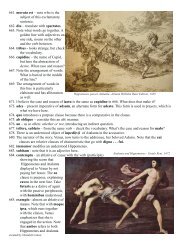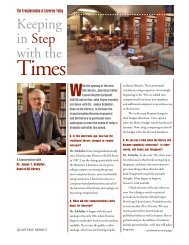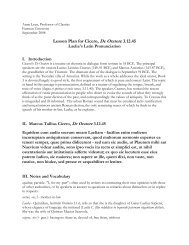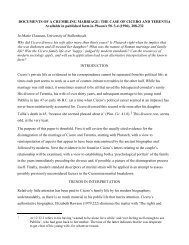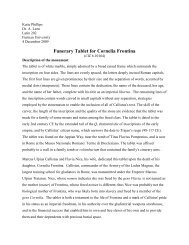Illustrating the Case for Funerary Monuments - College of New ...
Illustrating the Case for Funerary Monuments - College of New ...
Illustrating the Case for Funerary Monuments - College of New ...
Create successful ePaper yourself
Turn your PDF publications into a flip-book with our unique Google optimized e-Paper software.
American Classical League 2010 Institute<br />
Latin <strong>Funerary</strong> Inscriptions: Texts <strong>for</strong> Retrieving Women's Lives<br />
"<strong>Illustrating</strong> <strong>the</strong> <strong>Case</strong> <strong>for</strong> <strong>Funerary</strong> <strong>Monuments</strong>"<br />
Ann R. Raia, The <strong>College</strong> <strong>of</strong> <strong>New</strong> Rochelle<br />
In this panel we focus on <strong>the</strong> evidence funerary monuments provide about Roman women<br />
<strong>of</strong> <strong>the</strong> lower classes who lived during <strong>the</strong> late Republic and first two centuries <strong>of</strong> <strong>the</strong> Empire.<br />
I will introduce <strong>the</strong> topic <strong>of</strong> <strong>the</strong> panel and in my PowerPoint presentation I will share with you<br />
some examples <strong>of</strong> monuments from The Online Companion you might use in your Latin<br />
classroom. Judith Sebesta will demonstrate what inscriptions can teach us about <strong>the</strong> lives <strong>of</strong><br />
Roman girls. Anne Leen will tell you about her experiences using funerary inscriptions with<br />
her Latin class; her student, Alexander Rice, will describe his completed inscription project.<br />
Keely Lake's response to our presentations will open <strong>the</strong> floor <strong>for</strong> questions and discussion.<br />
Slide 2: Death <strong>of</strong> family, friends, or dependents was a common experience in Roman life,<br />
Saller tells us. 1 Responding to <strong>the</strong> human impulse to honor and memorialize <strong>the</strong>ir dearly<br />
departed, Romans <strong>of</strong> every class erected monuments according to <strong>the</strong>ir means. These have<br />
survived in great numbers, even if we know only a small fraction <strong>of</strong> <strong>the</strong> total in Bodel's<br />
estimate! 2 On <strong>the</strong>m, Romans present <strong>the</strong>mselves and <strong>the</strong>ir sentiments, giving us in<strong>for</strong>mation<br />
that o<strong>the</strong>r sources ignored as uninteresting, trivial, or common. Modern historians and<br />
archaeologists, on <strong>the</strong> o<strong>the</strong>r hand, attend closely to burials and <strong>the</strong>ir artifacts which <strong>of</strong>fer<br />
insight into Roman society, culture, and economy.<br />
Like ancestor masks in elite homes, funeral monuments kept <strong>the</strong> dead among <strong>the</strong> living.<br />
Janus-faced, <strong>the</strong>y not only housed <strong>the</strong> dead metaphorically -- Slide 3: in fact, some tombs<br />
are in <strong>the</strong> shape <strong>of</strong> houses --, <strong>the</strong>y also engaged with <strong>the</strong> living, both loved ones who visited<br />
on festal days and strangers, curious about <strong>the</strong> status and identity <strong>of</strong> <strong>the</strong> deceased. Many<br />
tombs seem designed to attract <strong>the</strong> attention <strong>of</strong> passers-by.<br />
Slide 4: Banned from within <strong>the</strong> city walls as early as <strong>the</strong> Twelve Tables, burials lined <strong>the</strong><br />
roads leading out <strong>of</strong> Rome and filled <strong>the</strong> suburbs. The Via Appia was a prime venue.<br />
Ironically, its grandest monuments did not survive <strong>the</strong> depredations <strong>of</strong> time and looters<br />
1
isking punishment under Roman law. The monument <strong>of</strong> <strong>the</strong> aristocrat Caecilia Metella,<br />
stripped <strong>of</strong> its marble, survived only as a medieval <strong>for</strong>tress.<br />
Roman tombs show great <strong>for</strong>mal diversity. Unlike Roman society, distinction was based not<br />
on class but on wealth. Slide 5: The wealthy freedwoman Naevoleia Tyche commissioned<br />
this sumptuous marble altar with money from her family business, placing it prominently<br />
outside Pompeii's Herculaneum gate. Its exterior was intended to impress; its simple interior<br />
held her cremated remains and those <strong>of</strong> her husband, C. Munatius Faustus and her<br />
freedpersons.<br />
The period from <strong>the</strong> end <strong>of</strong> <strong>the</strong> Republic saw burial by inhumation as well as cremation.<br />
Tombs <strong>of</strong> <strong>the</strong> 2 nd century CE show both types, but by <strong>the</strong> end <strong>of</strong> <strong>the</strong> 3 rd century Romans<br />
settled on inhumation. Archaeology has revealed <strong>the</strong> extremes <strong>of</strong> burials: at <strong>the</strong> lowest end<br />
<strong>the</strong> penniless and infants were interred directly in <strong>the</strong> earth in a cloth wrap or a broken<br />
amphora without a permanent marker.<br />
Those who could af<strong>for</strong>d it built free-standing monuments <strong>for</strong> <strong>the</strong>ir nuclear family and heirs<br />
(sepulchra hereditaria). Slide 6: This marble tomb on <strong>the</strong> Via Appia (<strong>the</strong> plaster cast <strong>of</strong> <strong>the</strong>ir<br />
portraits is in Rome's Terme Museum) was dedicated by Hermodorus and his wife Demaris,<br />
probably fellow slaves from Egypt who were owned and freed by <strong>the</strong> family <strong>of</strong> <strong>the</strong> Rabirii.<br />
Beside <strong>the</strong>m is possibly a descendent whose image was added later, a Priestess <strong>of</strong> Isis,<br />
Usia Prima, flanked by her symbols <strong>of</strong> <strong>of</strong>fice (<strong>the</strong> sistrum and patera) in low relief.<br />
Slide 7: Brick chamber tombs like this one on <strong>the</strong> Via Appia, were intended <strong>for</strong> burials <strong>of</strong> <strong>the</strong><br />
family, dependents and <strong>the</strong>ir descendents (sepulchra familiaria or household tombs); <strong>the</strong>ir<br />
inside walls were lined with niches <strong>for</strong> cinerary containers.<br />
Slide 8 (multiple): At <strong>the</strong> end <strong>of</strong> <strong>the</strong> Republic, senatorial families began to build large<br />
structures separate from <strong>the</strong>ir own monuments to hold <strong>the</strong> ashes <strong>of</strong> <strong>the</strong>ir slaves. Called<br />
columbaria, <strong>the</strong>y were <strong>the</strong> private property <strong>of</strong> <strong>the</strong>ir owners who <strong>of</strong>ten accommodated<br />
dependents as well as o<strong>the</strong>r petitioners. These multi- storied complexes featured open<br />
areas within, where families could ga<strong>the</strong>r to visit <strong>the</strong>ir dead on anniversaries and festal days.<br />
2
Livia erected a columbarium that <strong>of</strong>fered 1100 spaces <strong>for</strong> double burials, which proved<br />
insufficient <strong>for</strong> her households; she herself, however, was buried in Augustus’ tomb. This<br />
small columbarium in Ostia on <strong>the</strong> Via Ostiense bears evidence that free lower-class<br />
Romans also sought to secure an eternal home at a price <strong>the</strong>y could af<strong>for</strong>d by joining burial<br />
associations (collegia funeraticia).<br />
Slide 9: The large columbarium <strong>of</strong> Villa Doria Pamphilj on <strong>the</strong> Via Aurelia retains its wall<br />
decorations, which may have been a regular feature <strong>of</strong> columbaria. Here <strong>the</strong> rows between<br />
<strong>the</strong> niches were enlivened with colorful scenes from nature and daily life. Above each niche<br />
a placard (tabula ansata) was painted <strong>for</strong> <strong>the</strong> name <strong>of</strong> <strong>the</strong> deceased.<br />
Slide 10: The columbarium <strong>of</strong> <strong>the</strong> influential Statilius family was among <strong>the</strong> three largest in<br />
Rome. Its niche labels (tituli) are rich sources <strong>of</strong> in<strong>for</strong>mation about slave occupations in a<br />
wealthy household. Two examples illustrate <strong>the</strong> diversity <strong>of</strong> tituli in this columbarium:<br />
[CLICK] Logas was a companion (pedisequa) to <strong>the</strong> grandmo<strong>the</strong>r <strong>of</strong> <strong>the</strong> empress<br />
Messalina. As she was only 16 at her death and presumably unmarried, her mo<strong>the</strong>r<br />
AP[h]RODISIA dedicated this simple stone marker <strong>for</strong> her niche. Labels could be made <strong>of</strong><br />
wood, terracotta, plaster, or marble; <strong>the</strong>ir letters could be incised, as this is, or painted in<br />
carbon or red.<br />
[CLICK] Nothus was a secretary. This marble niche cover dedicated by his wife is one <strong>of</strong><br />
<strong>the</strong> more elegant memorials in <strong>the</strong> columbarium <strong>of</strong> <strong>the</strong> Statilii. It bears a 6-line poem [see<br />
#1 in your handout <strong>for</strong> <strong>the</strong> transcription and a literal translation] expressing her grief at<br />
her husband's premature death. Her pride in him was so self-effacing that she did not<br />
inscribe her name -- only <strong>the</strong> word coniunx. While it is doubtful she composed <strong>the</strong> elegy<br />
herself, she allowed <strong>the</strong> sentiments and <strong>the</strong> added expense <strong>of</strong> a versifier, indications <strong>of</strong> both<br />
wifely devotion and status.<br />
Slide 11: Cinerary urns that filled <strong>the</strong> niches in tombs and columbaria also show great<br />
diversity. The simplest were unadorned, <strong>of</strong> terracotta or marble [2 examples].<br />
Slide 12: Their shape, design, and customized decoration were determined by <strong>the</strong> buyer’s<br />
ability and willingness to pay. [6 examples]<br />
Slide 13: Those with greater means assuaged <strong>the</strong>ir grief with creative urns such as <strong>the</strong>se:<br />
Aurelia Vitalis' small urn <strong>for</strong> her grandmo<strong>the</strong>r, pictured reclining on <strong>the</strong> lid <strong>of</strong> a small<br />
sarcophagus-like container.<br />
[CLICK]<br />
Publius Nonius Zethus, a baker at Ostia, commissioned a large marble block to be<br />
carved with an inscription and <strong>the</strong> tools <strong>of</strong> his trade on <strong>the</strong> front like a sarcophagus; <strong>the</strong><br />
eight cavities on <strong>the</strong> top were designed to hold cinerary urns <strong>for</strong> himself, his wife, and<br />
workers.<br />
Slide 14 (multiple): Women were frequently memorialized with funerary altars; space was<br />
provided on <strong>the</strong> top <strong>for</strong> a cinerary urn, while <strong>the</strong> façade contained an inscription and <strong>of</strong>ten a<br />
relief portrait.<br />
3
Sarcophagi contained inhumation burials <strong>of</strong> <strong>the</strong> wealthy; <strong>the</strong>se were situated beside a road,<br />
inside private gardens, or within a family tomb. Slide 15 (multiple): The facade and lid <strong>of</strong><br />
<strong>the</strong> sarcophagus <strong>of</strong>fered a large field <strong>for</strong> displaying scenes from <strong>the</strong> life <strong>of</strong> <strong>the</strong> deceased or<br />
from mythology. The so-called Biographical Sarcophagus presented <strong>of</strong>ten generic episodes<br />
in <strong>the</strong> life <strong>of</strong> males, progressing through a cycle from birth, surrounded by women, to<br />
development and adult achievement, surrounded by men, to marriage (this example can be<br />
found in Rome's Massimo Museum). The 2 nd century CE sarcophagus <strong>of</strong> Metilia Acte, a<br />
freedwoman and priestess <strong>of</strong> Magna Mater in Ostia, and her freedman husband Euhodus, is<br />
decorated with <strong>the</strong> myth <strong>of</strong> Alcestis and Admetus. Although <strong>the</strong> myth is a frequent choice <strong>for</strong><br />
<strong>the</strong> burial <strong>of</strong> a matrona, in this case <strong>the</strong> faces are portraits <strong>of</strong> <strong>the</strong> deceased. This late<br />
Republican sarcophagus portrays on its lid draped portraits <strong>of</strong> a freedperson couple,<br />
Aurelia Agrippina and Publius Aelius Myron. Typically, both women are celebrated <strong>for</strong> <strong>the</strong>ir<br />
piety as sanctissima.<br />
Slide 16: A favorite <strong>the</strong>me on all types <strong>of</strong> funerary monuments was <strong>the</strong> defining moment <strong>of</strong><br />
<strong>the</strong> Roman citizen marriage, <strong>the</strong> dextrarum iunctio. These four examples from <strong>the</strong> 1 st -3 rd<br />
centuries illustrate important aspects <strong>of</strong> <strong>the</strong> ceremony, such as fertility symbolism<br />
(pomegranate, erotes), <strong>the</strong> bride's stola with its Heracles knot belt, <strong>the</strong> Pronuba presiding.<br />
Note <strong>the</strong> greater intimacy expressed in <strong>the</strong> poses <strong>of</strong> <strong>the</strong> couple on <strong>the</strong> last two monuments<br />
(<strong>the</strong> wife's hand is on his shoulder; <strong>the</strong>ir exchange <strong>of</strong> glances).<br />
• The 1 st century tombstone <strong>of</strong> <strong>the</strong> freeborn couple from Aquileia, dedicated by <strong>the</strong>ir<br />
children, is unusual: on <strong>the</strong> bottom are portraits <strong>of</strong> <strong>the</strong> deceased at <strong>the</strong> time <strong>of</strong> <strong>the</strong>ir<br />
marriage; at <strong>the</strong> top <strong>the</strong>y appear in old age: TVRPILLAE M[arci] F[iliae] / TERTIAE /<br />
MATRI (right) C[aio] ACVTIO / C[aii] F[ilio] / PATRI.<br />
• A beautifully sculpted cinerary urn <strong>of</strong> <strong>the</strong> 1 st century dedicated to <strong>the</strong> freedman<br />
Hermes by a friend.<br />
• A 2 nd century tombstone <strong>of</strong> a couple from Ostia, without identification.<br />
• A 3 rd century sarcophagus <strong>of</strong> an unidentified but important couple, surrounded by<br />
personifications <strong>of</strong> civic fertility and prosperity (Portus, Annona, Concordia, Genius <strong>of</strong><br />
<strong>the</strong> Senate, Abundantia, Africa).<br />
Sociologists and demographers use funerary inscriptions to extrapolate statistics about <strong>the</strong><br />
people and society <strong>of</strong> ancient Rome, such as life expectancy, ratio <strong>of</strong> male to female,<br />
numbers <strong>of</strong> slaves and freedpersons, varieties <strong>of</strong> relationships, family connections. When<br />
inscriptions accompany images, <strong>the</strong>y are rich sources <strong>for</strong> reconstructing <strong>the</strong> lives <strong>of</strong> nonelite<br />
women, who appear in great numbers on funerary monuments, as survivors and dearly<br />
departed.<br />
Slide 17: Claudia Prepontis commissioned this wall plaque and funerary altar <strong>for</strong> her<br />
<strong>for</strong>mer master, Tiberius Claudius Dionysius. She celebrates him in words as her patron and<br />
in image as her husband. Such testimony -- even if it is <strong>for</strong>mulaic-- furnishes in<strong>for</strong>mation<br />
beyond <strong>the</strong> mourner's intent. The simplest inscriptions <strong>of</strong>fer one or more elements: name<br />
and status, dedicator’s name and relationship, conventional words <strong>of</strong> praise -- sometimes<br />
age is included, but rarely date or cause <strong>of</strong> death.<br />
Lengthy inscriptions were not rare, even though <strong>the</strong>y would be costly. Slide 18: On this<br />
tablet [see #2 on your HANDOUT <strong>for</strong> <strong>the</strong> transcription and a literal translation] Furia<br />
4
Spes memorializes her relationship with her husband Sempronius Firmus, as well as <strong>the</strong><br />
emotional bonds that prompt her to pray <strong>for</strong> <strong>the</strong>ir swift reunion in death, a not unusual<br />
request.<br />
Slide 19: Let me conclude by introducing you to three women who can be found in<br />
Companion, where women are presented up close and as individuals -- in glossed Latin<br />
passages, in images, and as research options. They invite <strong>the</strong> reader to probe beyond<br />
statistics, stereotypes, and <strong>for</strong>mulae to imagine what women's lives might have been like.<br />
Slide 20 (multiple): Julia Capriola was a freedwoman <strong>of</strong> <strong>the</strong> Julian gens. Her image and<br />
inscription can be found in Companion 's World <strong>of</strong> Marriage, toge<strong>the</strong>r with an essay that<br />
explains what her monument can reveal about her. Reclining com<strong>for</strong>tably at <strong>the</strong> banquet <strong>of</strong><br />
life or perhaps at her 9-day funeral feast, this stern 35 year old matrona survived childbirth<br />
and disease to earn <strong>the</strong> traditional accolades <strong>of</strong> women: carissima and sanctissima.<br />
Slide 21 (multiple): Julia Secunda and her mo<strong>the</strong>r Cornelia Tyche, a freedwoman, were<br />
members <strong>of</strong> <strong>the</strong> family <strong>of</strong> <strong>the</strong> freedman Julius Secundus. They appear in Companion's<br />
World <strong>of</strong> Family. A 16 th century drawing shows what <strong>the</strong>ir hugely expensive tomb looked like<br />
originally. One <strong>of</strong> its walls contained a 14-line poem in hexameters commissioned by <strong>the</strong><br />
grieving fa<strong>the</strong>r and husband that movingly narrates <strong>the</strong>ir death in a shipwreck <strong>of</strong>f <strong>the</strong><br />
5
Spanish coast. In <strong>the</strong> inscription below <strong>the</strong>ir portraits he bears witness to <strong>the</strong>ir excellence:<br />
Julia, almost 12 years old, was dutiful as well as intelligent beyond her peers; Cornelia, 39<br />
and married to him <strong>for</strong> 11 years, was unmatched in her affection <strong>for</strong> him and exceptional in<br />
her devotion to her children.<br />
Title: Slide 21: I hope that you will visit Companion with your students in order to better<br />
know <strong>the</strong>se women and <strong>the</strong> many o<strong>the</strong>rs who can be found <strong>the</strong>re.<br />
Thank you <strong>for</strong> your attention. And now I will ask Judith Sebesta to step to <strong>the</strong> podium.<br />
The images reproduced here are from <strong>the</strong> VRoma Image Archive http://www.vroma.org<br />
1<br />
In his introduction to Commemorating <strong>the</strong> Dead: Texts and Artifacts in Context, Richard Saller<br />
writes: "The death <strong>of</strong> a family member, friend, or dependent was a far more common experience in<br />
<strong>the</strong> lives <strong>of</strong> Romans than <strong>for</strong> us today." in a foot note he adds "The mortality rate in developed<br />
countries today is under 15 per 1,000, in contrast to <strong>the</strong> Roman mortality rate <strong>of</strong> nearly 40 per 1,000<br />
per year" (Berlin, <strong>New</strong> York: Walter de Gruyter, 2008), p. 1.<br />
2<br />
In Chapter 6 <strong>of</strong> <strong>the</strong> same work, "From Columbaria to Catacombs: Collective Burial in Pagan and<br />
Christian Rome," John Bodel writes: "During <strong>the</strong> three and a half centuries <strong>of</strong> pre-Christian imperial<br />
Rome between <strong>the</strong> reigns <strong>of</strong> Augustus and Constantine, when <strong>the</strong> population <strong>of</strong> <strong>the</strong> city numbered<br />
between 750,000 and 1,000,000 inhabitants, <strong>the</strong> suburbs <strong>of</strong> <strong>the</strong> city must have accommodated<br />
between 10,500,000 and 14,000,000 burials. Of <strong>the</strong>se we have traces <strong>of</strong> perhaps 150,000 or less<br />
than 1.5 percent <strong>of</strong> <strong>the</strong> total," p. 179.<br />
6






